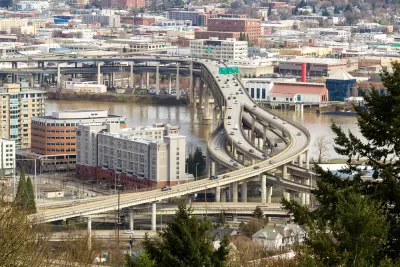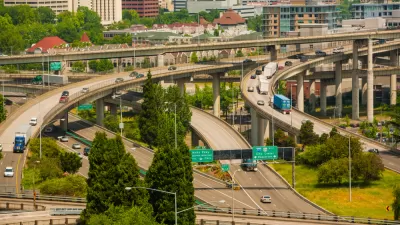Should plans to toll Interstates 5 and 205 in Portland get the go-ahead from the Oregon Transportation Commission and the Federal Highway Administration, they would still be subject to a state referendum.

As posted earlier this month, the Portland Metro Area Value Pricing Policy Advisory Committee issued its final recommendation to reduce congestion on Interstates 5 and 205 in the Portland region on July 5 to the Oregon Transportation Commission as required by congestion pricing legislation included in House Bill 2017.
According to the Oregon Department of Transportation [see FAQ on the Portland Metro Area Value Pricing Feasibility Analysis (pdf)], the committee had to choose between two congestion pricing tools:
- Priced lanes, in which drivers can choose to pay to use a managed lane and save time, or use an adjacent, unpriced lane. [If the priced lane allows free access for carpools, it is termed a high occupancy toll, or HOT lanes]
- Priced roadways, a concept under which all lanes would be priced to manage congestion. [Once again, free access for carpools can be considered.]
The committee chose the second approach: price the roadways, rather than individual lanes, but in phases—in two pilot projects, as posted July 9. The recommendation was sent to the Oregon Transportation Commission which will submit the final proposal to the Federal Highway Administration by year's end.
Citizens' Initiative
Les Poole, a planning commissioner from Gladstone, Clackamas County, 12 miles south of Portland, and state Rep. Mike Nearman, R-Independence (Polk County, Salem metro area), "have filed Initiative Petition 9, 'Tolls Need Voter Approval,' for the 2020 ballot," reports Paris Achen, capital bureau reporter for The Portland Tribune on July 24.
The initiative would amend the Oregon Constitution to require a vote of the people to implement tolls. Poole said he received notice from the secretary of state on Tuesday authorizing petitioners to begin gathering signatures for the initiative.
"Regardless of the validity of that concept, the (tolling) recommendations by ODOT (the Oregon Department of Transportation) are full of holes," Poole wrote in an email to the Pamplin/EO Capital Bureau.
Those recommendations are included in a lengthy report [pdf] to the Oregon Transportation Commission by the value pricing committee on July 5.
Putting the plan to a vote would hold state transportation officials accountable for addressing issues such as how the revenue from tolling will be used and preventing diversion of traffic into neighborhoods, [Poole] said.
How the revenues can be spent, and mitigations to prevent traffic diversion into neighborhoods, are part of the report, and also described more simply in the FAQ [pdf]. One of the questions in that document asks:
Q: Do people living in the region get a voice in the process and proposal that the OTC develops?
A: Yes. ODOT is holding a region-wide public conversation about congestion pricing through open houses, stakeholder meetings, surveys and online engagement.
It goes on to describe the formation of the 25-member [pdf] Value Pricing Policy Advisory Committee, which includes Mayor Anne McEnerny-Ogle of Vancouver, Wash, as residents or her city, the largest suburb in the Portland metro area, will be directly affected by the tolling plan, though they won't be able to vote should Petition 9 appear on the ballot in two years. However, Oregonians living hundreds of miles from Portland near the California and Idaho borders would get a say on whether the city can apply congestion pricing to its two interstates.
Furthermore, it would appear that should the petition pass, any plan to apply highway tolling, even on individual lanes as opposed to roadways, would be subject to a state vote as the initiative amends the state constitution.
In some ways, the initiative is reminiscent of how congestion pricing in New York City was decided by the New York State legislature in 2008, rather than the New York City Council, or requiring state legislation in California to allow cities like Los Angeles and San Francisco to apply cordon area congestion pricing. Of course, a major difference in Oregon is that there is no such requirement – it's the initiative process of direct democracy at work, and the Oregon legislature already authorized the plan when it passed HB 2017 last July.
So perhaps a better analogy would be the gas tax repeal initiative, Proposition 6, in California this November?
What all these examples have in common, though, is that they show how difficult it is to increase the price of driving, be it through tolls or gas taxes, without allowing for a wider say from the people, either directly or through their representatives, or both.
Planetizen archive on Portland interstate tolling project
- "Advisory Committee Recommends Complete Tolling of Portland Interstates," July 9, 2018: A Portland regional value pricing committee recommended that the state transportation department operate two pilot programs to toll all the lanes on two interstate highways in the Portland-Vancouver metropolitan area.
- "Priced Lane or Priced Roadway?" May 17, 2018: The Pacific Northwest's Portland-Vancouver metropolitan area is studying options to add congestion pricing to one or two interstates.
-
"Oregon's $3 Billion Transportation Funding Legislation Has a Tax for Almost Everyone,"July 7, 2017: The package, which doesn't tax walking and running shoes, went to the legislature on June 30. It includes a ten cents per gallon gas tax, a 0.10 percent payroll tax, a $15 tax on new bikes costing at least $200, and a potential toll on I–205.
FULL STORY: Initiative would require vote on tolls

Alabama: Trump Terminates Settlements for Black Communities Harmed By Raw Sewage
Trump deemed the landmark civil rights agreement “illegal DEI and environmental justice policy.”

Planetizen Federal Action Tracker
A weekly monitor of how Trump’s orders and actions are impacting planners and planning in America.

Why Should We Subsidize Public Transportation?
Many public transit agencies face financial stress due to rising costs, declining fare revenue, and declining subsidies. Transit advocates must provide a strong business case for increasing public transit funding.

Understanding Road Diets
An explainer from Momentum highlights the advantages of reducing vehicle lanes in favor of more bike, transit, and pedestrian infrastructure.

New California Law Regulates Warehouse Pollution
A new law tightens building and emissions regulations for large distribution warehouses to mitigate air pollution and traffic in surrounding communities.

Phoenix Announces Opening Date for Light Rail Extension
The South Central extension will connect South Phoenix to downtown and other major hubs starting on June 7.
Urban Design for Planners 1: Software Tools
This six-course series explores essential urban design concepts using open source software and equips planners with the tools they need to participate fully in the urban design process.
Planning for Universal Design
Learn the tools for implementing Universal Design in planning regulations.
Caltrans
Smith Gee Studio
Institute for Housing and Urban Development Studies (IHS)
City of Grandview
Harvard GSD Executive Education
Toledo-Lucas County Plan Commissions
Salt Lake City
NYU Wagner Graduate School of Public Service




























